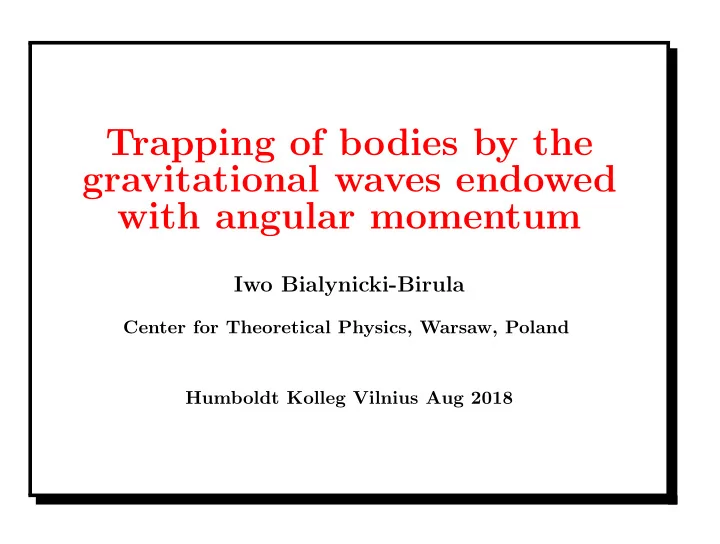

Trapping of bodies by the gravitational waves endowed with angular momentum Iwo Bialynicki-Birula Center for Theoretical Physics, Warsaw, Poland Humboldt Kolleg Vilnius Aug 2018
Prologue “What the principal investigator would like to be“trapped”? If these are elementary particles, then gravity is much too weak, as compared to other forces at those scales If they are massive bodies (e.g. stars or compact objects), then there are no physically motivated sufficiently strong gravitational waves to achieve this”
Electromagnetism Gravitation
Electromagnetism Gravitation
Angular momentum of a binary system of two equal masses √ Gm 3 r = Gm 2 √ 2 r L = c r S Example: Black holes with 30 solar masses spiraling at the distance of 10 Schwarzschild radii have the angular momentum hundred thousand times the angular momentum of the Earth on its orbit around the Sun
Angular momentum luminosity for a binary system of two masses √ G 7 / 2 m 9 / 2 4 mc 2 dL dt = 32 2 r 7 / 2 = c 5 5( r/r S ) 7 / 2 5 Example: Black holes with 30 solar masses spiraling at the distance of 10 Schwarzschild radii emit per second six million times the angular momentum of the Earth on its orbit around the Sun
Bessel beams carry angular momentum Bessel beams in electromagnetism and gravity can be obtained as derivatives of the superpotential χ λMq z q ⊥ ( ρ, φ, z, t ) = e − iλ ( ω q t − q z z − Mφ ) J M ( q ⊥ ρ ) Quantum numbers: � λ - helicity � ω q - energy � M - z -component of total angular momentum � q z - z -component of momentum � q ⊥ - transverse momentum
Geodesic motion d 2 ξ µ dξ α dξ β dτ 2 + m grav Γ µ m inert dτ = 0 αβ dτ τ is the proper time Galileo-Einstein m inert = m grav Mass disappears Motion is universal d 2 ξ µ dξ α dξ β dτ 2 + Γ µ dτ = 0 αβ dτ
The simplest geodesic trajectory Experts in numerical gravity claim that the dominant contribution to gravitational radiation emitted by inspiraling binaries comes from the M = 2 component of radiation and I will consider only this case Owing to the axial symmetry of Bessel beams there is one natural candidate for a geodesic: the z -axis
Uniform motion along the z -axis 4-velocity has the form: dξ α dτ = { u 0 , 0 , 0 , u 3 } Relevant components of the Christoffel symbol vanish dξ α dξ β Γ µ αβ = 0 ( α = 0 , 3 β = 0 , 3) ⇛ Γ µ dτ = 0 αβ dτ Therefore, the motion is uniform d 2 ξ µ dτ 2 = 0
Geodesic deviation Is the geodesic trajectory along the z -axis stable? The answer is obtained from the equation of geodesic deviation d 2 η µ dξ α dξ β dτ 2 = R µ dτ η ν αβν dτ R µ Riemann curvature tensor αβν
What is geodesic deviation? ξ k λ η i λ Reference geodesic is drawn in red
Riemann curvature tensor R 1 001 = − 2 k 4 + B M − 2 − 4 k 2 ⊥ k 2 + B M − 2 k 4 ⊥ B M +2 , R 1 002 = 2 k 4 + B M − 2 − 2 k 4 ⊥ B M +2 , R 1 003 = − 4 k ⊥ k 3 + B M − 1 − 4 k 3 ⊥ k + B M +1 , R 2 002 = 2 k 4 + B M − 2 − 4 k 2 ⊥ k 2 + B M − 2 k 4 ⊥ B M +2 , · · · where B M = AJ M ( k ⊥ ρ ) cos( k ∥ + Mφ − ωt ) A is the amplitude that determines the strength Looks very complicated, however. . .
Motion near the reference trajectory Reference trajectory ξ i ( τ ) along the z -axis d 2 η 1 dt 2 = − γω 2 ( η 1 cos( ωt ) + η 2 sin( ωt )) , d 2 η 2 dt 2 = − γω 2 ( η 1 sin( ωt ) − η 2 cos( ωt )) , d 2 η 3 dt 2 = 0 .
In the frame rotating with ω/ 2 Coriolis force overcomes repulsion d 2 η 1 dt 2 = (1 / 4 − γ ) ω 2 η 1 + ωdη 2 dt d 2 η 2 dt 2 = (1 / 4 + γ ) ω 2 η 2 − ωdη 1 dt Eigenfrequencies in the rotating frame: √ Ω ± = ω 1 / 4 ± γ
In the inertial frame The motion in the inertial frame is characterized by 4 frequencies: √ Ω ± ± = ω (1 / 2 ± 1 / 4 ± γ )
Conclusion Gravitational waves may carry with them all kinds of cosmic debris The trapping of these bodies near the beam axis is due to the Coriolis force
Recommend
More recommend